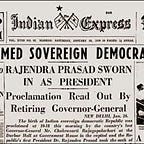XLV: India’s Gilded Age
The rise and rise of India’s Bollygarchs
This was originally earmarked as National Identity XXVI. Nineteen editions and three years later talking about India’s Gilded Age, her robber barons, her moguls is even more relevant. In that time, the concentration of wealth at the top has only become more pronounced despite India suffering the sharpest contraction on record in 2020. To be clear, this has been a global phenomenon as cheap credit has fuelled multiple asset price bubbles. However, a handful of families in India control not only the economy but also political parties at a time when elections are prohibitively expensive, and divisive, affairs. This hinders reform, stifles competition and negatively impacts consumers and workers.
— — — — — — — — — — — — — — — — — — — — — — — — — — — — -
1 | A Protectionist Racket
The Bombay Club, a group of inter-generational gilded robber barons, sat huddled together in a club in Bombay in 1991 and cried hoarse about the liberalisation of the Indian economy and the impending rush of foreign goods. How could their companies, for decades protected by the ‘Licence-Quota-Permit Raj’ or simply, the ‘Licence Raj’, compete with the full force of Japanese carmakers or American cereals or European pesticides? The economic crisis in 1991 was precipitated by a balance of…
